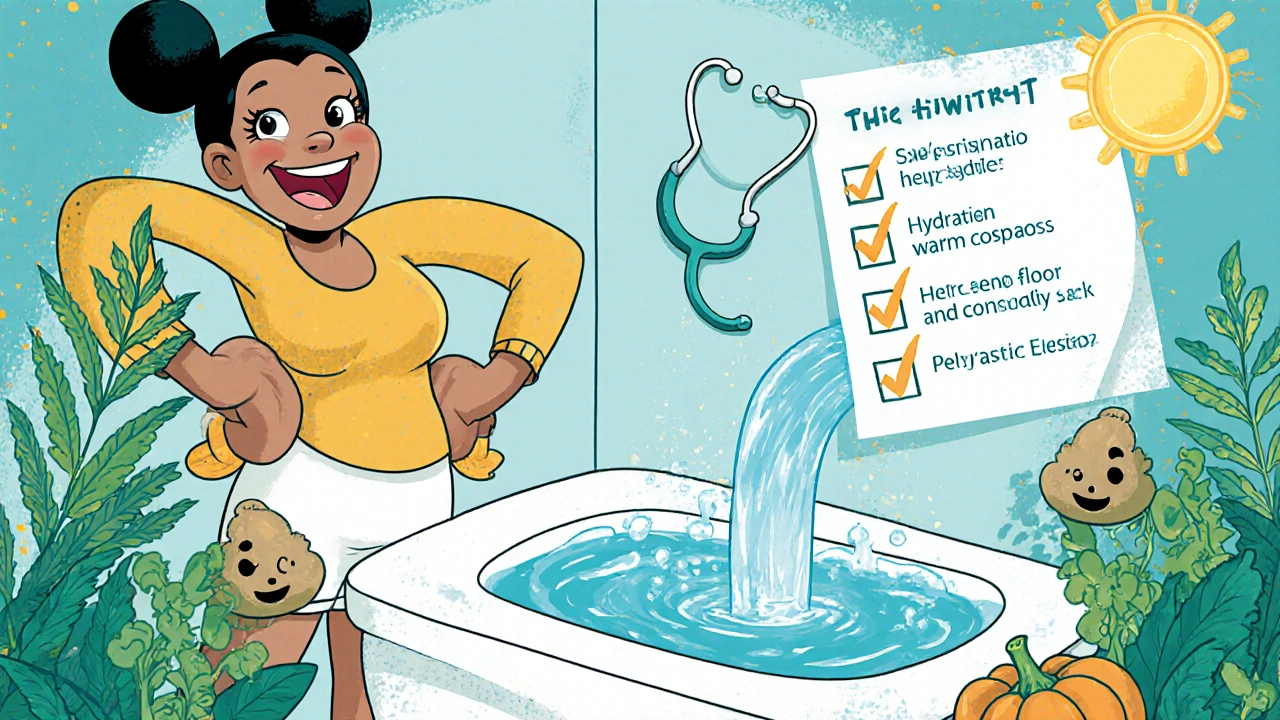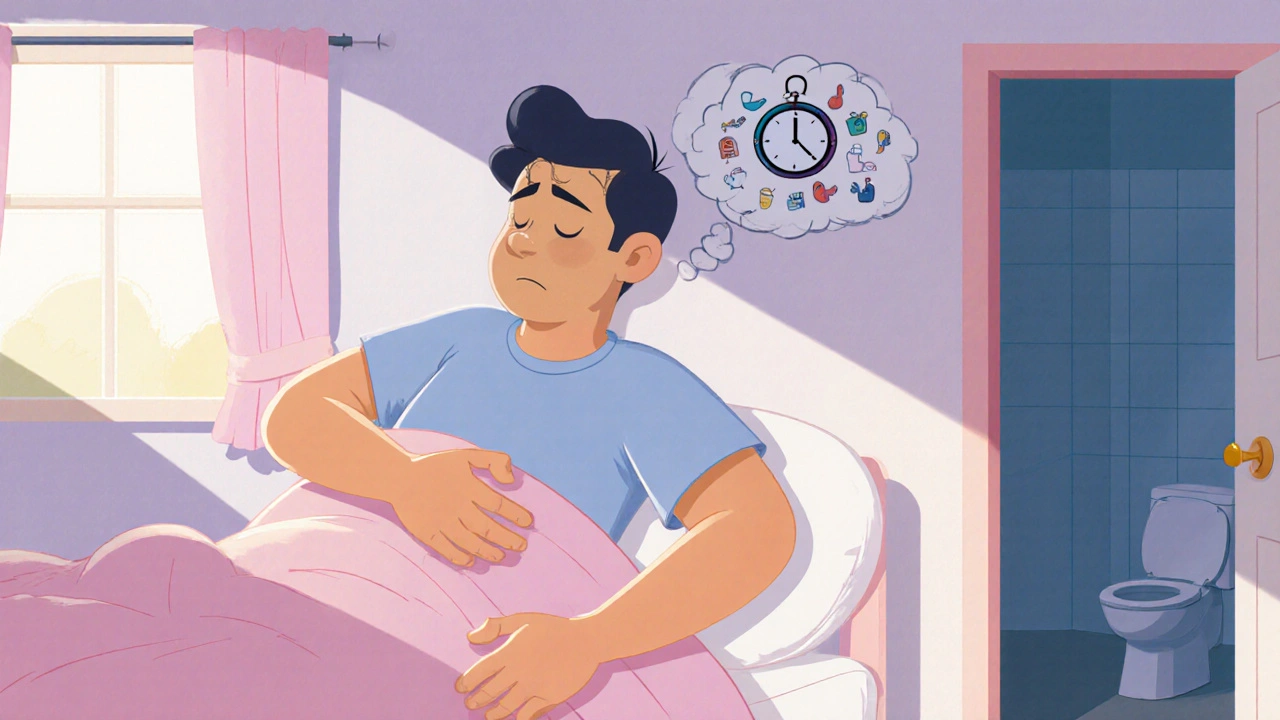Personalized Hydration Calculator
Calculate Your Optimal Daily Water Intake
Based on the article content about home remedies for difficulty urinating, proper hydration is essential for urinary health. This calculator determines your personalized daily water intake based on your individual needs.
Recommended Daily Water Intake
Enter your information to see your personalized hydration recommendation.
Imagine waking up and feeling like you can’t empty your bladder properly - that pressure, that irritation, the constant trip to the bathroom that never seems to finish. It’s an uncomfortable problem that many people face, and the good news is you don’t always need a prescription to find relief.
Quick Takeaways
- Stay hydrated but avoid over‑drinking right before bed.
- Warm compresses and pelvic‑floor exercises often give the quickest improvement.
- Herbs like saw palmetto and pumpkin seed oil can help, but evidence varies.
- Avoid high‑caffeine drinks, alcohol, and “quick‑fix” tonics that lack scientific backing.
- Seek medical help if symptoms persist beyond a few weeks or are accompanied by pain, blood, or fever.
What “Difficulty Urinating” Really Means
Difficulty urinating is a condition where a person experiences trouble starting, maintaining, or completing the act of urination. It can manifest as a weak stream, a feeling of incomplete emptying, or the need to strain before the flow begins. While occasional hiccups happen to everyone, chronic trouble may signal an underlying issue that deserves attention.
When the bladder can’t fully empty, pressure builds up, increasing the risk of infections and kidney damage over time. Understanding the root cause helps you choose the right remedy.
Common Triggers You Can Adjust at Home
Before diving into specific remedies, it’s worth noting a few everyday habits that often aggravate the problem:
- Low fluid intake. Dehydration concentrates urine, making it harder to pass.
- Excess caffeine or alcohol. Both act as irritants and diuretics, prompting the bladder to contract irregularly.
- Holding urine too long. Stretching the bladder reduces its contractility.
- Poor posture. Slouching can compress the pelvic floor, limiting flow.

Proven Home Strategies That Actually Work
These techniques have the best blend of scientific backing and user reports.
Water intake - The Foundation
Drinking enough water (about 1.5‑2 liters daily for most adults) dilutes urine and promotes steady flow. Aim for regular sips rather than gulping large amounts at once, especially in the evening, to avoid nighttime trips.
Warm compress - Relax the Muscles
Applying a warm, moist towel or heating pad to the lower abdomen for 5-10 minutes before attempting to pee can relax the sphincter and smooth muscle. The heat increases blood flow, easing the opening of the urinary tract.
Pelvic floor exercises - Build Control
Also known as Kegels, these exercises strengthen the muscles that support bladder emptying. Perform a set of 10‑15 slow contractions, holding each for 5 seconds, three times a day. Over a few weeks most people notice a steadier stream and less straining.
Bladder training - Re‑teach Your Body
Schedule bathroom visits at regular intervals (every 2-3 hours) even if you don’t feel the urge. Gradually extend the interval; this trains the bladder to hold and release urine more efficiently.
Diet tweaks - Reduce Irritants
- Cut back on spicy foods, citrus, and artificial sweeteners.
- Choose low‑sodium meals to lessen fluid retention.
- Include magnesium‑rich foods (leafy greens, nuts) that help muscle relaxation.
Herbal & Natural Aids - What Science Says
Nature offers several botanicals that may support urinary flow, but the evidence ranges from strong to anecdotal.
| Herb / Supplement | Typical Dose | Evidence Level | Likely Benefit |
|---|---|---|---|
| Saw palmetto | 320 mg daily | Moderate (small RCTs) | May improve flow in benign prostatic hyperplasia |
| Pumpkin seed oil | 1 tsp (5 ml) daily | Low‑to‑moderate | Supports bladder muscle tone |
| Cranberry extract | 500 mg daily | Low (mainly infection prevention) | May reduce irritation but not flow |
| D‑mannose | 500 mg 2‑3×/day | Low | Prevents infections that worsen retention |
| Apple cider vinegar | 1‑2 tsp in water | Very low | Insufficient data; potential acidity irritation |
Among these, saw palmetto and pumpkin seed oil have the most consistent positive reports for men with prostate‑related blockage. Women may benefit from pumpkin seed oil for general bladder tone.
What Doesn’t Work - Common Myths Debunked
Here are home tricks that sound promising but have little to no proven benefit:
- Extreme fluid restriction. Skipping water only concentrates urine and can increase irritation.
- High‑dose diuretics like coffee or tea. They increase urgency without improving flow.
- “Miracle tonics” sold online. Many contain unknown compounds and may interact with medications.
- Heavy‑metal herbal mixes. Without regulation, safety is questionable.

Safety First - When to Call a Professional
If you notice any of the following, stop self‑treatment and see a clinician:
- Blood in urine.
- Painful burning during urination.
- Fever, chills, or flank pain - signs of infection or kidney involvement.
- Inability to urinate at all (acute urinary retention).
- Symptoms persisting longer than two weeks despite home measures.
Doctors can run simple tests (urinalysis, ultrasound) to rule out stones, infections, or prostate enlargement and prescribe targeted medication if needed.
Putting It All Together - Your Personalized Action Plan
Use the checklist below to craft a routine that fits your lifestyle.
- Start the day with a glass of water - keep a bottle handy.
- Schedule a warm compress before bedtime and before each bathroom visit for the first week.
- Do pelvic floor exercises twice daily (morning + night).
- If you’re a man over 40, consider a daily 320 mg saw palmetto supplement after consulting your pharmacist.
- Replace afternoon coffee with herbal tea (chamomile or peppermint) to cut caffeine.
- Track progress in a simple log: time, volume, any discomfort.
Give yourself at least three weeks to notice change. If the stream remains weak or you’re still straining, it’s time for a professional evaluation.
Bottom Line
While severe urinary blockage often needs medical treatment, many people find relief with practical home steps: stay hydrated, use warmth, strengthen the pelvic floor, and choose evidence‑backed botanicals wisely. Avoid quick‑fix remedies that lack research, and never ignore warning signs like pain or blood.
Can drinking more water make the problem worse?
No, proper hydration actually helps dilute urine and promotes smoother flow. Over‑drinking right before sleep can increase nighttime trips, so spread intake throughout the day.
Are there any foods that should be avoided?
Spicy dishes, citrus fruits, and artificial sweeteners can irritate the bladder lining. Reducing them often eases urgency and improves flow.
How long does it take to see results from pelvic floor exercises?
Most people notice a steadier stream after 2‑4 weeks of consistent Kegel practice. Patience is key; the muscles need time to strengthen.
Is saw palmetto safe for women?
Research is limited, but low‑dose saw palmetto is generally considered safe for women when used short‑term. Consult a healthcare provider if you’re pregnant or nursing.
When should I seek immediate medical help?
If you cannot urinate at all, experience severe pain, notice blood, or develop fever, go to the emergency department right away. These can signal acute retention or infection.


Alex Pegg
October 20, 2025 AT 16:51Americans shouldn't be buying foreign herbal supplements when a simple warm compress works just fine.
laura wood
November 1, 2025 AT 13:27I get why you might reach for quick fixes, but staying hydrated and using heat are both safe and affordable ways to ease the strain.
Rajesh Myadam
November 13, 2025 AT 11:03Difficulty urinating is a common complaint that often stems from lifestyle factors rather than serious disease.
Hydration plays a crucial role, as concentrated urine can irritate the bladder lining and make voiding harder.
Drinking about two liters of water daily, spread evenly throughout the day, helps keep the urine dilute.
It is equally important to avoid large fluid loads before bedtime to reduce nocturnal awakenings.
Warm compresses applied to the lower abdomen for ten minutes before attempting to void relax the detrusor muscle and improve flow.
Regular pelvic‑floor training, commonly known as Kegels, strengthens the muscles that control urinary release and can reduce straining.
A typical regimen involves ten slow contractions held for five seconds each, performed three times a day.
Bladder training, in which you schedule bathroom visits at fixed intervals, retrains the bladder’s capacity and urgency signals.
Dietary adjustments, such as limiting caffeine, alcohol, spicy foods, and artificial sweeteners, minimise bladder irritation.
Incorporating magnesium‑rich foods like leafy greens, nuts, and seeds may further support muscle relaxation.
For men with prostate enlargement, saw palmetto at a dose of 320 mg daily has shown modest improvement in urinary flow in several small trials.
Women may benefit from pumpkin seed oil, which appears to support overall bladder muscle tone.
It is essential to monitor for red‑flag symptoms such as blood in the urine, pain, fever, or inability to urinate, as these warrant prompt medical evaluation.
Keeping a simple log of fluid intake, voiding times, and any discomfort can help you track progress and identify patterns.
With consistent adherence to these home strategies, most individuals notice a steadier stream within two to four weeks.
Andrew Hernandez
November 25, 2025 AT 08:39Warm compresses and regular Kegels are cheap tricks that actually work.
Deja Scott
December 7, 2025 AT 06:15I appreciate the straightforward advice; a simple heat pad and consistent exercises can be enough for many people.
Mahesh Upadhyay
December 19, 2025 AT 03:51Relying on miracle tonics is a foolish gamble; you deserve real science.